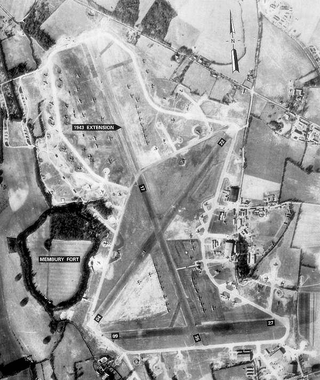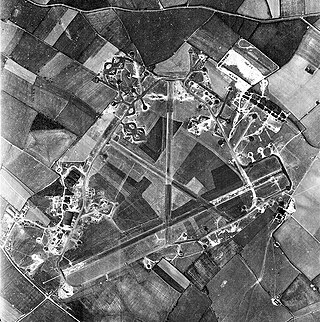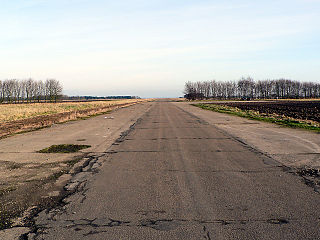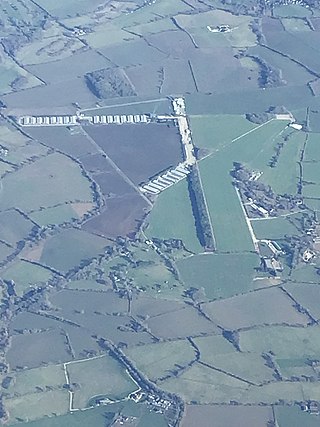
Royal Air Force Bruntingthorpe or more simply RAF Bruntingthorpe is a former Royal Air Force station located 4.2 miles (6.8 km) north east of Lutterworth, Leicestershire and 10 miles (16 km) south of Leicester, Leicestershire, England.

Royal Air Force Gaydon or more simply RAF Gaydon is a former Royal Air Force station located 5.2 miles (8.4 km) east of Wellesbourne, Warwickshire and 10.8 miles (17.4 km) north west of Banbury, Oxfordshire, England.

Royal Air Force Membury or more simply RAF Membury is a former Royal Air Force station built in the civil parish of Lambourn in Berkshire, England, approximately 4.6 miles (7.4 km) north-northwest of Hungerford. The airfield was opened on the site of a civil airfield in August 1942, and closed in October 1946.

Royal Air Force Chelveston or more simply RAF Chelveston is a former Royal Air Force station located on the south side of the B645, 5 miles (8.0 km) east of Wellingborough, near the village of Chelveston in Northamptonshire, England. During the Second World War the airfield was occupied by both the Royal Air Force and the United States Army Air Forces. It was given the USAAF designation Station 105.

Royal Air Force Grimsby or more simply RAF Grimsby is a former Royal Air Force station located near Grimsby, Lincolnshire, England. The site was operational during the Second World War as part of RAF Bomber Command initially as a satellite station for the Vickers Wellington bombers of RAF Binbrook. By early 1943 the station was equipped with Avro Lancaster bombers of No. 100 Squadron RAF.

Royal Air Force Goxhill or RAF Goxhill is a former Royal Air Force station located east of Goxhill, on the south bank of the Humber Estuary, opposite the city of Kingston upon Hull, in north Lincolnshire, England.

RAF Westcott is a former Royal Air Force station located near Westcott in Buckinghamshire, England. The site fully opened in September 1942 and was the base of No.11 Operational Training Unit (OTU) flying the Vickers Wellington medium bomber until the RAF moved out in August 1945, the station was officially closed on 3 April 1946.

Haverfordwest Airport, also known as Withybush Airport, is a minor airport located 2 NM north of Haverfordwest, Pembrokeshire. It is on the site of the former RAF Haverfordwest, which was operational between 1943 and 1945. Pembrokeshire County Council bought the site in the 1950s, and it has been a civil airfield since, with a number of other organisations also using it.

Royal Air Force Hemswell or more simply RAF Hemswell is a former Royal Air Force (RAF) station located 7.8 miles (12.6 km) east of Gainsborough, Lincolnshire, England.
Tatenhill Airfield is a licensed airfield operated by Tatenhill Aviation Ltd. Its CAA Ordinary Licence allows flights for the public transport of passengers and for flying instruction as authorised by the licensee, Tatenhill Aviation. The three runways are paved, but one is no longer operational, and a second is used only occasionally. Running east–west, the main runway is the longest.

Royal Air Force Elgin or RAF Elgin, also known as Bogs of Mayne, is a former airfield operated by the Royal Air Force and located approximately 1.5 kilometres (0.93 mi) south west of Elgin in Moray, Scotland. It opened in 1940 as a satellite airfield of RAF Lossiemouth and was used throughout the Second World War, predominantly by bomber aircraft of No. 20 Operational Training Unit. Towards the end of the war it was used by No. 46 Maintenance Unit, before it closed in 1947. The site was returned to agricultural use, although several airfield buildings and a memorial remain.

Royal Air Force Metheringham or more simply RAF Metheringham is a former Royal Air Force station situated between the villages of Metheringham and Martin and 12.1 mi (19.5 km) south east of the county town Lincoln, Lincolnshire, England.
Royal Air Force Wickenby, or more simply RAF Wickenby, was a purpose-built Royal Air Force satellite station constructed late 1942 and early 1943. It lies halfway between Wickenby and Holton cum Beckering, to the south-east of Wickenby close to the B1399 in West Lindsey, 8 NM north-east of Lincoln, England.
Royal Air Force Honeybourne, or more simply RAF Honeybourne, was a Royal Air Force station located 0.6 miles (0.97 km) south of Honeybourne, Worcestershire, England and 4.6 miles (7.4 km) east of Evesham, Worcestershire, England
RAF Tatenhill is a former Royal Air Force satellite airfield in Tatenhill, Staffordshire, England, 4 NM west of Burton on Trent. It was originally known as RAF Crossplains.
Royal Air Force Ashbourne, or more simply RAF Ashbourne, is a former Royal Air Force station located approximately 1.5 miles (2.4 km) south-east of the town of Ashbourne, Derbyshire, England.

Royal Air Force Finmere, or more simply RAF Finmere is a former Royal Air Force satellite station located to the south-east of Finmere and south of Tingewick, a few miles west of Buckingham. Whilst the village of Finmere is in Oxfordshire, the whole of RAF Finmere was located within the north-west corner of Buckinghamshire. It was served by the nearby Finmere railway station.

RAF Holme-on-Spalding Moor, or more simply RAF Holme is a former Royal Air Force station located in the East Riding of Yorkshire, England.

Royal Air Force Cammeringham or more simply RAF Cammeringham was a Royal Air Force station used by RAF Bomber Command between 1940 and 1945 and the Polish Air Force until 1946. The airfield was located between the A15 and B1398 roads, 10.3 mi (16.6 km) north of the city Lincoln, Lincolnshire, England and due east of the village of Ingham.

Royal Air Force Wing or more simply RAF Wing is a former Royal Air Force station, situated just west of the village of Wing, in the Aylesbury Vale district of Buckinghamshire, England.

















